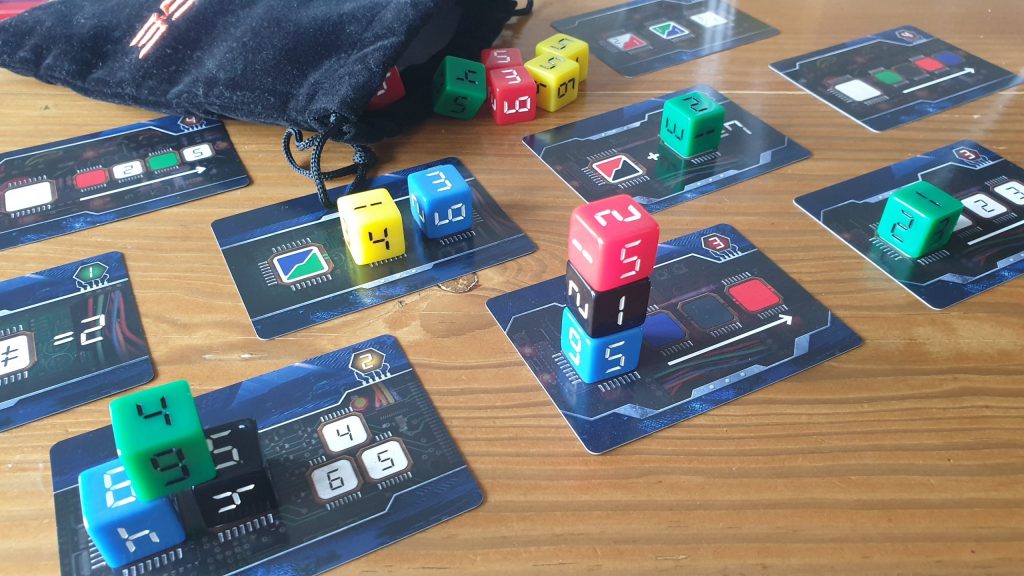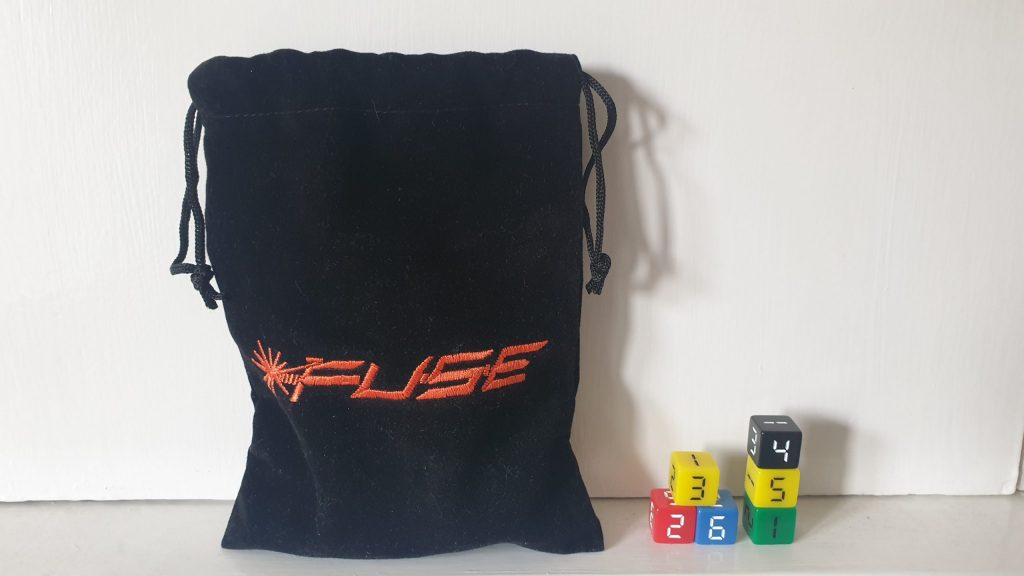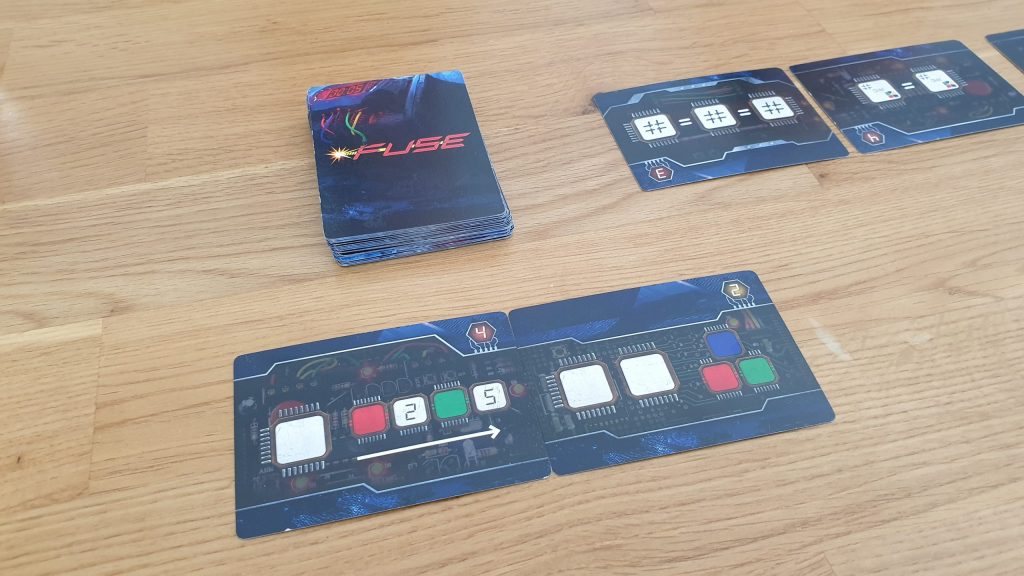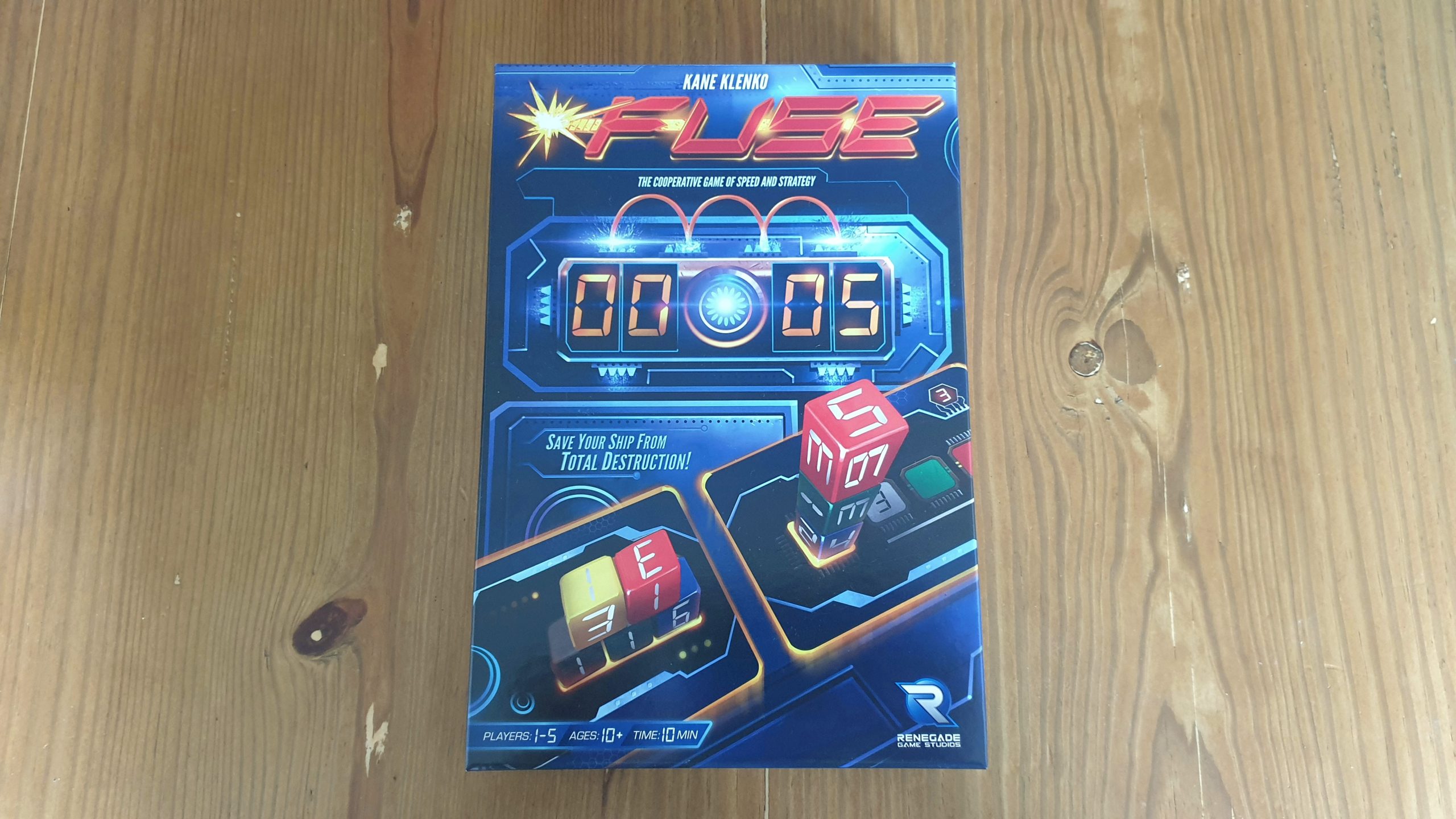FUSE is a real time, cooperative board game from publisher Renegade Game Studios, released originally back in 2015. Designed by Kane Klenko, the game sees 1 – 5 players hastily attempting to disarm a bomb, with the help of some dice! For around 10 minutes players will be rolling dice, frantically using them to complete combinations – all against a ticking timer. However, is FUSE a blast to play? Let’s find out!
In FUSE there are no rounds, for much of each turn everyone is involved, and it is all against a timer. Setting up the bomb deck is shuffled, with a number of cards removed for lower player counts. This is also the stage where 6 valued advanced cards and fuse cards can be shuffled in for increased difficulty. Each player gets dealt a couple of bomb cards, which they place face up in front of themselves. Everyone should be approximately given one easier and one harder card, with every card having a number assigned to them (1 – 6) to denote their difficulty. Therefore, if when dealing out someone gets two 4 valued cards one is shuffled back into the deck and they are dealt a new card until they get an easier one. A market row of 5 available bomb cards is then dealt out to the middle of the table, with the rest of the deck placed at one end.
FUSE is played in real time over a 10 minute period. As soon as players start the timer then a lot can happen simultaneously. On a turn the active player draws as many dice from the back as there are players, rolling them for all to see. Players discuss what is available and each must take one of the dice and add it to one of their bomb cards. If any dice cannot be used then it becomes an unused die. This is rolled and then each player must remove a die matching the colour or number from their cards. Play continues with the dice bag being passed clockwise, with a new player becoming the active player.

Every bomb card is unique, though there is repetition in the style of cards. Some will see the player creating a stack or pyramid of dice, while others will just see dice placed on different spaces indicated on the card. As the card difficulty increases the number of requirements increases on the cards. For example, a level one card that is looking for a stack may require any two dice to be stacked on top of each other, followed by a green die of any value followed by any die. At the opposite end of the spectrum card spaces might require an exact combination of colour and value (a blue 3), or need all dice on the card to match value wise.
When a player fills all of the spaces on a bomb card it is completed. The player discards the used dice back into the dice bag, putting the completed card to one side. A new card is then drawn from the available market, before being replenished. As a team players must work through the deck. The cards in front of players don’t need to be completed. However, the market of 5 cards needs to be empty and the deck must be depleted for the bomb to be defused. Winning or losing as a team, players can calculate a group score – by summing the difficulty values on the completed cards, with bonuses for time left on the clock and fuse cards activated.
For first time players it is best to do a dummy round, passing the bag around the table once without the pressure of the countdown. Making sure the team has a variety of the objectives, players can ask questions and make sure they understand the icons. This makes the experience that bit more comfortable when against the timer, as stopping the game to ask a question can be daunting for some. Note, that pausing the timer is possible though. All it takes to reset is reshuffling the deck and throwing the dice back in the bag, so very little time is spent via this more interactive teach.

As if winning a game of FUSE wasn’t a hard enough challenge, there are multiple ways to up the difficulty. This extends past merely upping the number of cards a team must complete. Included are some level 6 advanced bomb cards, which require more specific things and/or more dice to complete them. There are also fuse cards which work similarly to unused dice. When these come out of the deck each player must lose a die of the indicated type, be it a colour of dice or of the denoted value. These cards might be instantly discarded, but they still slow down the progress of the team.
The game seems a little easier at 4 – 5 players compared to 2 – 3. Mostly, this is due to there being more players, which increases the chance of someone being able to take dice. While this wouldn’t stop me playing again with 2 for the challenge, it means it is more of a go to game when 4 are at the table. Upkeep is in real time, which adds to the hectic feel of the experience. It is more noticeable at a low player count though. Especially with 2 players where 4 dice are rolled, as when one player is replenishing the market that is 50% of the people playing.
FUSE is a stressful 10 minute experience, so it won’t be for everyone. There is a real feeling of pressure, with the timer noisily ticking down and multiple players often wanting the same dice. At the end of a game it isn’t uncommon to breathe a sigh of relief. The experience can sometimes be tarnished by dice that hate you, with no way to mitigate bad luck. Thankfully, the short playtime allows losses to be forgotten about, as players won’t have invested hours of time into a loss. Even including setup and teardown the game only lasts around 11 minutes.

Many games aim to but fail to force players into working together. Quarterbacking, where one player can dictate moves to others, is often the downfall of good coop titles. FUSE gets around this as players don’t have time to work out what everyone else needs. Players therefore have to rely on others. This makes communication highly important, as no one wants to lose already placed dice as a result of some going unused.
Production wise FUSE is a solid game. The FUSE embossed bag for the chunky dice works well, stopping players knowing what colours they’ll pull out. The box could be smaller to increase portability. Though, plenty of dice and a deck of cards are included, so at most it could be a third smaller. FUSE doesn’t come with a timer included, though there is one available in the free to download Renegade app. While any 10 minute timer would suffice, the Renegade app version ramps up the tension. By using fast paced beating music, and a GLaDOS-like computer voice shouting at the players, it makes watching the time tick away ever harder.
The gameplay may look or sound hectic, yet there is some organisation to the chaos. Players will need to rush, and they will feel the pressure and stress thanks to the timer. When all of the communication comes together though, winning gives players a true sense of satisfaction. Even the easy difficulty isn’t a walk in the park. Thanks to the stress levels a sense of relief is sometimes present which can make players want to stop after a win, as the game can become a little repetitive. As soon as the next game night rolls around though players will be eager to try again. FUSE is the type of filler that can be played in 10 minutes but it will stay on your table for an hour as you play to get a win, the sign of a great game!
(Editor’s Note: FUSE was provided to us by Asmodee for the review. The game is currently available from local board game stores! Find your local store here.)

